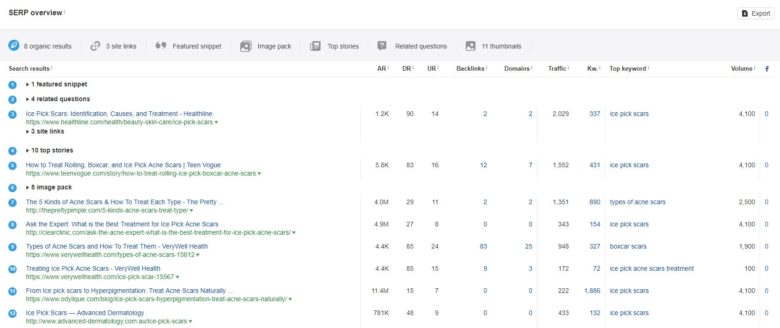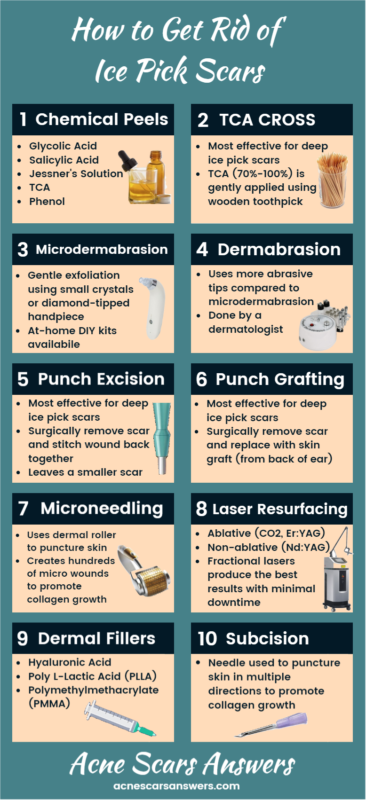
Here's my step-by-step plan to generate traffic, inspired by a great tutorial by Sam Oh at Ahrefs.
The goal is to get onto the first page of Google.
Last month, I mentioned some free SEO tools like Ubersuggest and Keywords Everywhere.
This month, I took advantage of the 7-day trial at Ahrefs for $7 to complete all the keyword research for this initial stage.
While free tools are good, there's a huge difference between free and paid SEO tools.
Let me show you what I mean.
Here's a screenshot from Ahrefs of a keyword that looks pretty attractive.

The keyword is "ice pick acne scars" and the parent topic is "ice pick scars".
Starting at the top left box, we see the estimated Keyword Difficulty is 0, meaning this keyword is quite easy to rank for.
The box to the right shows the Monthly Search Volume is 800 and the box further on its right shows the Monthly Clicks are around 500.
Generally, you should be cautious if click volume is below search volume.
In this case, however, I believe people aren't finding what they want on the SERPs (Search Engine Results Page, also known as Page 1 of Google), which is why they're not clicking on the results.
The last thing I want to point out is the Parent Topic ("ice pick scars").
As the name suggests, the parent topic is the most commonly used keyword phrase related to the current keyword. And we see that this parent topic has a much higher search volume of about 4,000 per month, which is encouraging.
Moving down the page, the next section is an overview of the SERPs.

By the way, this is all explained in Ahrefs' YouTube videos so don't worry if you feel a little lost.
There are two columns that I look at to understand if I can really outrank the competition and get my content onto the first page.
The backlinks column shows how many links there are to that page. This metric is important for ranking well in Google and is similar to a "popularity index".
The referring domains column shows a similar metric but instead of URLs, it counts only the number of websites (domains).
If we look at the results, there's actually 3 URLs that have 0 referring domains and 0 backlinks. Furthermore, the top result (HealthLine) has only 2 referring domains and 2 backlinks.
This is considered incredibly low which is why Ahrefs assigned a Keyword Difficulty of 0 (it estimates KD based on the average number of backlinks on Page 1).
So what does this mean? It means if I can create a piece of relevant content of similar quality and have just 1 referring domain (1 backlink), I should be able to outrank these competitors and get onto page 1 of Google.
It's not exactly as simple as that, because of factors like Domain Authority (HealthLine is obviously a lot more reputable), but it's a good way to think about these metrics.
After completing the keyword research process, we now have our list of low-competition keywords. Onto the next step, content planning.
Before creating content, I like to have a planning session to determine what exactly I'm going to write about. Here are some general steps to take:
Group together keywords that are similar or related because one piece of content will likely rank for all of these keywords, so no need to duplicate efforts.
For example, "how to get rid of ice pick scars" and "remove ice pick scars" are two common keyword derivatives from the same parent topic on "ice pick scars".
One tell-tale sign that an article can rank for all these keywords is if the SERPs look roughly the same for each keyword. This suggests that Google treats the keywords in a similar manner since it provides similar page results.
Now that you have more general "topics" with specific keywords attached, the next step is to prioritize the content by search volume so that we target topics with greater traffic potential first, then work down to topics with lower traffic potential.
This is where having a high quality SEO tool is important as you want to have the most accurate data on search volume.
The last step is to decide how often you'll publish a blog post and schedule those in your calendar or set reminders to make sure you stay on top of content creation.
I'm aiming for 2 pieces of high quality content a week but I recognize this will fluctuate as I get better at the content creation process.
My principles for content creation are:
Make sure to always serve the Search Intent. That's the problem or question that prompted someone to search for the keyword.
Relevant content helps solve someone's problem or answer someone's question.
I struggle with this one because I'm analytical at heart and love details.
There is nothing worse for your reader than writing unorganized and overly complicated content.
Simple content gets to the point and is easy to understand.
This may seem at odds with "Keep It Simple" but these are two different concepts.
Content can be comprehensive in scope yet still simple to understand.
Comprehensive does not mean "boiling the ocean" and including every piece of information.
For me, it means two things:
1) Provide sufficient information for someone to make a decision, and
2) Provide more or better information than all of the competitors (become a "one-stop shop")
Today, everyone scans first and then decides if something's worth reading.
Make content more scannable by:
It's 2018 and we all know the power of social media.
When content gets shared, someone out there is endorsing your brand and telling others that you have something worth sharing.
But how do you create something like that?
For now, I'm using two methods:
1) Create Stunning Infographics: I think people are more likely to share great images, such as a stunning infographic, which are easy to pin onto a Pinterest board. I was inspired by the awesome infographics over on Dr. Axe's website which summarizes a long article into its key points.
2) Create Comprehensive Content: I think people are more likely to bookmark and share content that truly stands out from the competition. In this case, by providing more comprehensive information to help people make decisions or purchases.
Using these exact steps, I wrote a blog post on the topic "ice pick scars" that is:
Example of Infographic on Ice Pick Scars
